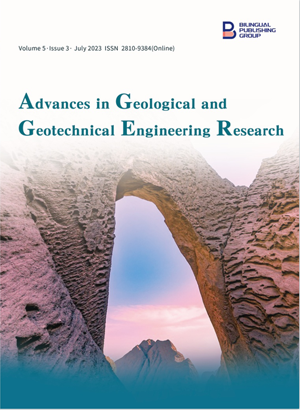-
153
-
141
-
131
-
131
-
120
On the Possible Cometary Nature of the Uchur Cosmic Body (Fall 3.08. 1993)
DOI:
https://doi.org/10.30564/agger.v5i3.5705Abstract
An expeditionary study of the area of the alleged impact event that occurred on 3.08.1993 in the area of the Lower Konkuli River (southeast of the Aldan Highlands, Lurikan Range, Russia) was carried out. According to the materials of remote sensing, the places of collision with the earth of a cosmic body are determined. In the area of the impact of the shock wave on the Earth’s surface, peat samples were selected, the micro probe analysis of which showed the presence of a cosmogenic substance in concentrations 6-8 times higher than the background. Silicate and magnetite micro spheres, native iron, moissanite, and carbon micro tubes coated with a film consisting of pure nickel were found. Of particular interest were the findings of specific Ni film micro structures that allow us to make an assumption about the cometary nature of the Uchur cosmic body. Most researchers associate the observed flights of fireballs with the subsequent fall of meteorites. Researchers are trying to find the massive body of the fallen space body. However, often, even after many years of searching, a massive cosmic body cannot be found. This happened when studying the site of the fall of the Tunguska cosmic body. In this case, it remains to be assumed that the cosmic body contained microscopic dust particles. The structure and composition of such particles can only be studied using microscopic research methods. When studying the Uchur cosmic body, the authors concluded that it could be of a cometary nature due to the findings of specific particles—thin films of pure nickel on the surface of plant remains of terrestrial origin. This hypothesis arose from the recent discovery of atomic nickel vapors in comets.
Keywords:
Uchur cosmic body; Impact event; Cosmogenic matter; Microtubes; Nickel films; Microstructures; Cometary natureReferences
[1] Гусяков В.К., 2021. От Чикскулуба до Челябинска: космические катастрофы наЗемле. (Russian) [From Chikskulub to Chelyabinsk: Space catastrophes on Earth. Science First Hand]. Наука из первых рук. 1/2(91), 6-27.
[2] Tselmovich, V.A., Kurazhkovskii, A.Yu., Kazansky, A.Yu., et al., 2019. Studying the dynamics of cosmic dust flux on the Earth’s surface from peat deposits. Izvestiya, Physics of the Solid Earth. 55, 517-527.
[3] Песков, А.Ю., Крутикова, В.О., Захарченко, Е.Н., et al., 2020. ГЕОХИМИЯ И МАГНЕТИЗМ Т О Р ФЯ Н И КО В М Е Ж Д У Р Е Ч ЬЯ Р Е К ХОР И КИЯ, СИХОТЭ-АЛИНЬ (ПРЕДВАРИТЕЛЬНЫЕ ДАННЫЕ) (Russian) [Geochemistry and magnetism of peatlands in the in terfluous of the Khor and Kia rivers, Sikhote-alin (preliminary data)]. ТИХООКЕАНСКАЯ ГЕОЛОГИЯ. 39(2), 79-89.
[4] Васильев, Н.В., 2004. Тунгусский метеорит. Космический феномен лета 1908 года. М.: Русская панорама (Russian) [Space phenomenon in the summer of 1908]. Russian panorama: Moscow. pp. 359.
[5] Кринов, Е.Л., 1981. Железный дождь (Russian) [Iron rain]. Nauka: Moscow. pp. 191.
[6] Дудоров, А.Е., 2020. Частота падений метеоритов и болидов (Russian) [The frequency of falling meteorites and fireballs]. Астрономический вестник. 54(3), 247-259.
[7] Kulagin, V.P., Shustov, B.M., Kuznetsov, Y.M., et al., 2016. Methods and means of information-analytical assessment of asteroid and comet hazard. Solar System Research. 50, 464-470. DOI: https://doi.org/10.1134/S0038094616070145
[8] Bobrowsky, P.T., Rickman, H., 2007. The asteroid impact hazard and interdisciplinary issues. Comet/asteroid impacts and human society. An interdisciplinary approach. Springer-Verlag: Berlin. pp.146-162.
[9] Ivanov, B.A., Hartmann, W.K., 2007. Exogenic dynamics, cratering and surface ages. Treatiseon geophysics. Elsevier: Amsterdam. pp. 207-242.
[10] Амелин, И.И., Гусяков, В.К., Ляпидевская, З.А., 2013. Методика оценки частоты импактных событий (Russian) [Methods for estimating the frequency of impact events]. Проблемы информатики. 4, 21-35.
[11] Витязев, А.В., Печерникова, Г.В., 1997. Астероидная и сейсмическая опасность: введение в новые аспекты проблемы (Russian) [Asteroid and seismic hazard: An introduction to new aspects of the problem]. ИФЗ РАН. 69.
[12] Кириллов, В.Е., 2004. Маршрутами, тропамии дорогами. Из бродяжьих воспоминаний дальневосточного геолога-поисковика (Russian) [Routes, paths and roads. From the vagabond memoirs of a Far Eastern prospecting geologist]. Хабаровск. 146.
[13] Badyukov, D.D., Ivanov, A.V., Raitala, J., et al., 2011. Spherules from the Tunguska event site: Could they originate from the Tunguska Cosmic Body? Geochemistry International. 49, 641-653.
[14] Цельмович, В.А. (editor), 2015. Возможность микроскопической диагностики космической пыли в торфе. Метеориты, астероиды, ком е т ы . М ат е р и а л ы м е ж д у н а р од н о й конференции и школы молодых ученых (Russian) [The possibility of microscopic diagnostics of cosmic dust in peat. Meteorites, asteroids, comets. Materials of the International Conference and School of Young Scientists]; 2015 May 21-23; Miass. p. 93-196.
[15] Цветков, В.И., 1989. Сихоте-Алиньский метеорит (Russia) [Sikhote-Alin meteorite]. Nature. 8, 78-85.
[16] Antipin, V.S., Yazev, S.A., Perepelov, A.B., et al., 2005. The 25 September 2002 Vitim meteorite: Results of complex research. Russian Geology and Geophysics. 46(10), 1050-1064.
[17] Kolesnikov, E.M., Longo, G., Bettger, T., et al., 2003. Isotope-geochemical study of nitrogen and carbon in peat from the explosion site of the Tunguska space body. Icarus. 161(2), 235-243.
[18] Manfroid, J., Hutsemékers, D., Jehin, E., 2021. Iron and nickel atoms in cometary atmospheres even far from the Sun. Nature. 593(7859), 372-374. DOI: https://doi.org/10.1038/s41586-021-03435-0
[19] Guzik, P., Drahus, M., 2021. Gaseous atomic nickel in the coma of interstellar comet 2I/Borisov. Nature. 593(7859), 375-378.DOI: https://doi.org/10.1038/s41586-021-03485-4
Downloads
How to Cite
Issue
Article Type
License
Copyright © 2023 Tselmovich Vladimir A., Amelin Ivan I. , Gusiakov Viacheslav K., Kirillov Vadim E., Kurazhkovskii Alexander Yu.

This is an open access article under the Creative Commons Attribution-NonCommercial 4.0 International (CC BY-NC 4.0) License.




 Tselmovich Vladimir A.
Tselmovich Vladimir A.






